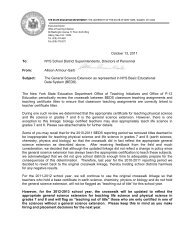ESL Learning Standards - Higher Ed - New York State Education ...
ESL Learning Standards - Higher Ed - New York State Education ...
ESL Learning Standards - Higher Ed - New York State Education ...
You also want an ePaper? Increase the reach of your titles
YUMPU automatically turns print PDFs into web optimized ePapers that Google loves.
Standard 3: Continued<br />
Elementary Grade Sample Classroom Tasks:<br />
English Proficiency Level<br />
Beginning<br />
Teacher provides groups of students with copies of a newspaper.<br />
After becoming somewhat familiar with basic contents<br />
and format, students cut out pictures of people working.<br />
In groups, students place pictures on posters and<br />
label the occupations. Students talk about the jobs of people<br />
they know. They choose one job and act it out, and<br />
the class guesses the occupation. Students draw a picture<br />
of their chosen job and explain why they like it.<br />
Performance indicators: 1, 3, 7<br />
Intermediate<br />
Teacher provides groups of students with copies of a newspaper.<br />
After becoming familiar with basic contents and format,<br />
students review the different sections of the newspaper<br />
(one section per group). Students cut out items of<br />
interest and create a poster for presentation to the class.<br />
Members of each group plan the presentation by discussing<br />
what is of interest and who will present each item. Groups<br />
present their posters. Class completes a teacher-made<br />
reflection sheet featuring categories such as “surprises,”<br />
“most interesting,” and “already known”<br />
Performance indicators: 1, 3, 4, 7<br />
<strong>ESL</strong><br />
3<br />
Elem<br />
Teacher divides class into cooperative groups. As a first<br />
task, students select a name for their group. Members propose<br />
possible names and group reaches consensus.<br />
Groups design posters to represent their group and chosen<br />
name. Cooperative groups may work on a variety of class<br />
projects.<br />
Performance indicators: 3, 6, 7<br />
Teacher presents the Pocahontas story, using a documentary<br />
video (e.g., “Pocahontas: Ambassador of the <strong>New</strong><br />
World” [A&E Network]) and/or picture books. In groups,<br />
students select an incident to reenact. With teacher’s help,<br />
the class discusses and evaluates the actions of the characters<br />
in each scene. The teacher captures the language.<br />
Each group makes life-size drawings of the characters in<br />
their scene and attaches language bubbles from the information<br />
collected by the teacher.<br />
Performance indicators: 1, 3, 7<br />
Students complete Beginning task. Class reads The Three<br />
Little Pigs and True Story of the Three Little Pigs by John<br />
Scieszka. Students prepare for a mock trial of the wolf.<br />
Groups take on roles of judge, jury, defendant, plaintiffs,<br />
and attorneys. Trial is conducted and jury renders verdict.<br />
Judge hands down sentence. Students each write a<br />
response to the verdict, indicating reasons for agreement or<br />
disagreement. They share responses in class.<br />
Performance indicators: 1, 2, 3, 4, 6, 7<br />
Students complete Beginning task. Students watch the<br />
Disney movie Pocahontas. In small groups students use a<br />
T-chart to speculate as to what is true and what is<br />
Hollywood fiction. Teacher provides simple reference<br />
material, and groups check facts. Groups revise T-chart.<br />
Whole class discusses rationale for fictional embellishments.<br />
Performance indicators: 1, 2, 3, 7, 9<br />
56 <strong>Learning</strong> <strong>Standards</strong> for <strong>ESL</strong>
















